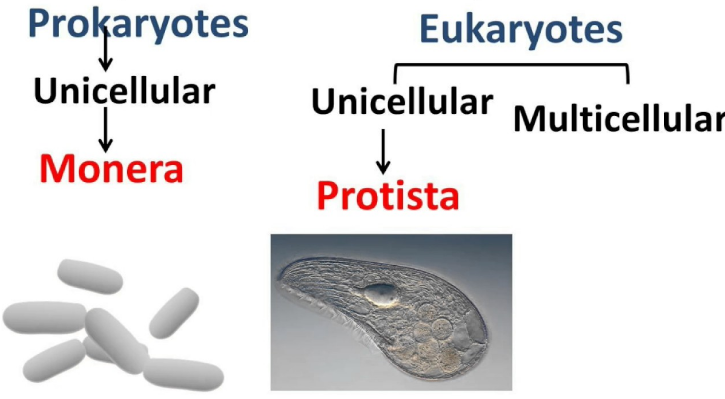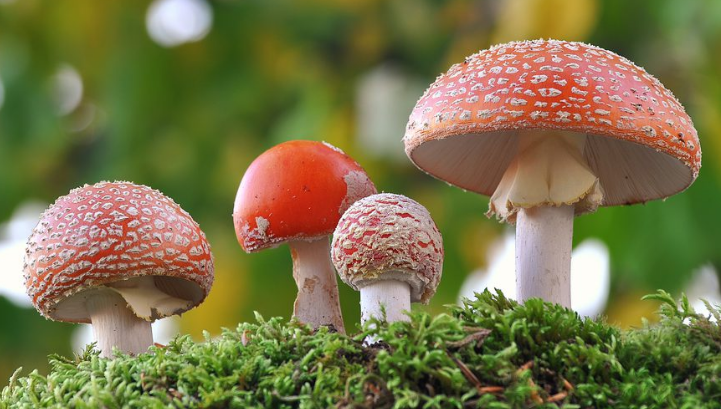Learn the difference between Monera, Protista and Fungi. The basis of comparison include: Cell structure, classification, complexity, cell wall, nucleus, cilia and flagella, examples, habitat, organelles, nucleoplasm and mode of nutrition.

Description of Kingdom Protista
The protista or protoctista are a kingdom of simple eukaryotic organisms that cannot be classified as plant, animal or fungus, usually composed of a single cell or a colony of similar cells. Organisms in protista kingdom are unique and very diverse. Algae, amoebas, euglena, paramecia and slime molds are a good example of protists. There are two major groups of protists which include the Protozoans, whose cells are similar to animal cells in that they do not have cell walls and the plant-like cells which do have cell walls and are similar to algae.
Description of Kingdom Monera
Monera is a kingdom in biology that comprises unicellular organisms with a prokaryotic cell organization such as bacteria. They are single-celled organisms with no true nuclear membrane or membrane bound organelles such as chloroplasts, golgi complex, mitochondria or endoplasmic reticulum. Monera have a cell wall of protein plus polysaccharide compound, but not cellulose. They reproduce asexually by binary fission. Kingdom monera is further divided into two groups Archaebacteria and Eubacteria.
Description of Kingdom Fungi
Fungi is a kingdom in biology that comprises a group of eukaryotic organisms that includes microorganisms such as yeast, molds as well as mushrooms. All fungi have a cell wall made of chitin material. Members of kingdom fungi are not motile and consist of threads known as hyphae. Fungi reproduce sexually and asexually by spore formation.
Kingdom Monera
The general features of Kingdom Monera include:
- Organism of kingdom Monera are single-celled prokaryotes and do not have a defined nucleus or organelles as in eubacteria or in cyanobacteria.
- Monerans exist virtually everywhere and in any condition (both living and non-living environments). They can be found in hot or thermal springs, under ice, in deep ocean floor and inside or outside the body of plants and animals.
- Monerans are classified as Archaebacteria, Eubacteria and Cyanobacteria.
- Some organisms have rigid cell walls composed of peptidoglycan while others do not have cell walls.
- Monerans do not have a membrane bound nucleus. The nucleus is without a clear envelope, nucleous, nucleoplasm, histone protein and true chromosomes. It is only DNA that is present.
- Circulation in monerans is through diffusion.
- Locomotion of these organisms is with the help of flagella. There are also some that are non-motile.
- Membrane bound organelles such as nucleus, mitochondria, endoplasmic reticulum, golgi apparatus are absent in monerans.
- They show different modes of nutrition like autotrophic, heterotrophic, parasitic, symbiotic, commensalistic, mutualistic or saprophytic.
- Organisms reproduce mostly asexual through fission or budding and in case it is sexual, then it is through conjugation, transformation and transduction.
- The modes of respiration in these organisms vary greatly, few organisms are obligate aerobes, while some are facultative anaerobes and others are obligate anaerobes.
- Examples of monerans include methanobacillus, Thiobacillus, Rhizobium, Clostridium, Anabaena, Nostoc, Streptomyces, Myobacterium etc.
Kingdom Protista
General characteristics of kingdom protista include:
- Members of kingdom prostista are unicellular, prokaryotic organisms with a well defined membrane-bound nucleus.
- Most of the protists live in water some in moist soil, some live in water while some inside or outside of plant and animal bodies.
- Protists can be classified as Diatoms, Unicellular algae, Molds or Protozoans.
- Cell Wall. Some protists like mold and algae have a cell wall composed of cellulose whereas others like protozoa do not have a cell wall.
- Protists have a well defined nucleus with nuclear envelope, nucleoplasm, nucleoulus, chromosomes, organelles and helical DNA.
- Circulation is through diffusion.
- Protists use appendages such as hair-like cilia or whip-like flagella for moving around.
- Membrane bound organelles such as nucleus, endoplasmic reticulum, mitochondria; Golgi bodies are very much present in protists.
- The mode of nutrition in protists can be autotrophic or heterotrophic. They also show photosynthetic, holozoic, saprophytic or parasitic mode of nutrition.
- Some protists reproduce asexually while other reproduces sexually by a process involving cell fusion and zygote formation.
- In protists, cellular respiration is the primary aerobic process, but some living in the moist soil underneath ponds or in digestive tracts of animals is facultative anaerobes.
- Examples of protists include Plasmodium falciparum, green algae, slime molds, Euglena, water molds, Amoeba and Paramecium.
Kingdom Fungi

Characteristic of kingdom fungi include:
- Almost all members of kingdom fungi are filamentous and multicellular with exception of yeast and mold which are unicellular.
- Most fungi generally grow in warm humid environments.
- Fungi can be classified as Microsporidia, Ascomycota, Glomeromycota, Basidiomycota, Chytridiomycota, Neocallimastigomycota and Blastocladiomycota.
- The fungi have cell walls made up of complex sugar molecules (polysaccharides) known as chitin.
- Fungi have a well defined nucleus with nuclear envelope, nucleoplasm, nucleoulus, chromosomes, organelles and helical DNA, but no chloroplasts.
- Circulation in fungi is through diffusion.
- Fungi are basically non-motile; they do not have cilia and flagella.
- Membrane bound organelles such as nucleus, endoplasmic reticulum, mitochondria; Golgi bodies are very much present in fungi.
- Most fungi have a heterotrophic mode of nutrition. Few species are saprophytes (they feed on dead and decaying organic matter.
- Reproduction in fungi takes place through vegetative means, that is, fragmentation, fission and budding.
- Most fungi are facultative anaerobes while others are obligate aerobes.
- Examples of fungi include yeast, mold, puccinia, mushrooms and penicillium.
- Some fungi such as puccinia cause diseases in plants and animals while others such as penicillium are sources of antibiotics.
- Most fungi have bodies that consist of long, slender thread-like stractures known as hyphae. The network of hephae is referred to as mycelium. Septa are also found in fungi, separating fungal hyphae into compartments.
Also Read: Difference Between Mold And Yeast
The Difference Between Monera, Protista And Fungi in Tabular Form
| BASIS OF COMPARISON | MONERA | PROTISTA | FUNGI |
| Cell Structure | Monera has a unicellular prokaryotic cellular organization which lack membrane-bound organelles. | Protista has a unicellular eukaryotic cellular organization. | Fungi are mostly multicellular. |
| Classification | Monerans are classified as Archaebacteria, Eubacteria and Cyanobacteria. | Protists can be classified as Diatoms, Unicellular algae, Molds or Protozoans. | Fungi can be classified as Microsporidia, Ascomycota, Glomeromycota, Basidiomycota, Chytridiomycota, Neocallimastigomycota and Blastocladiomycota. |
| Complexity | Monera are simple in structure, with no complexity. | Protista are complex in structure. | Simple in structure. |
| Cell Wall | They have a well developed cell wall composed of peptidoglycan. | They have a well developed cell wall composed of cellulose. | The fungi have cell walls made up of complex sugar molecules (polysaccharides) known as chitin. |
| Nucleus | Monera’s do not do not have a defined nucleus. | Protists have a well defined nucleus. | Fungi have a well defined nucleus. |
| Cilia and Flagella | Some monera have cilia and flagella for locomotion, while others do not have. | Protista hair-like cilia or whip-like flagella (pseudopodia). | Fungi are basically non-motile; they do not have cilia and flagella. |
| Nuclear Envelope, Nucleoplasm, Nucleolus and DNA | Monerans do not have a membrane bound nucleus. The nucleus is without a clear envelope, nucleous, nucleoplasm, histone protein and true chromosomes. It is only DNA that is present. | Protists have a well defined nucleus with nuclear envelope, nucleoplasm, nucleoulus, chromosomes, organelles and helical DNA. | Fungi have a well defined nucleus with nuclear envelope, nucleoplasm, nucleoulus, chromosomes, organelles and helical DNA, but no chloroplasts. |
| Mode of Nutrition | They show different modes of nutrition like autotrophic, heterotrophic, parasitic, symbiotic, commensalistic, mutualistic or saprophytic. | The mode of nutrition in protists can be autotrophic or heterotrophic. They also show photosynthetic, holozoic, saprophytic or parasitic mode of nutrition. | Most fungi have a heterotrophic mode of nutrition. Few species are saprophytes (they feed on dead and decaying organic matter. |
| Mode of Reproduction | Organisms reproduce mostly asexual through fission or budding and in case it is sexual, then it is through conjugation, transformation and transduction. | Some protists reproduce asexually while other reproduces sexually by a process involving cell fusion and zygote formation. | Reproduction in fungi takes place through vegetative means, that is, fragmentation, fission and budding. |
| Examples | Examples of monerans include methanobacillus, Thiobacillus, Rhizobium, Clostridium, Anabaena, Nostoc, Streptomyces, Myobacterium etc. | Examples of protists include Plasmodium falciparum, green algae, slime molds, Euglena, water molds, Amoeba and Paramecium. | Examples of fungi include yeast, mold, puccinia, mushrooms and penicillium. |
| Habitat | They can be found in hot or thermal springs, under ice, in deep ocean floor and inside or outside the body of plants and animals. | Most of the protists live in water some in moist soil, some live in water while some inside or outside of plant and animal bodies. | Most fungi generally grow in warm humid environments. |
| Organelles | Membrane bound organelles such as nucleus, mitochondria, endoplasmic reticulum, golgi apparatus are absent in monerans. | Membrane bound organelles such as nucleus, endoplasmic reticulum, mitochondria; Golgi bodies are very much present in protists. | Membrane bound organelles such as nucleus, endoplasmic reticulum, mitochondria; Golgi bodies are very much present in fungi. |